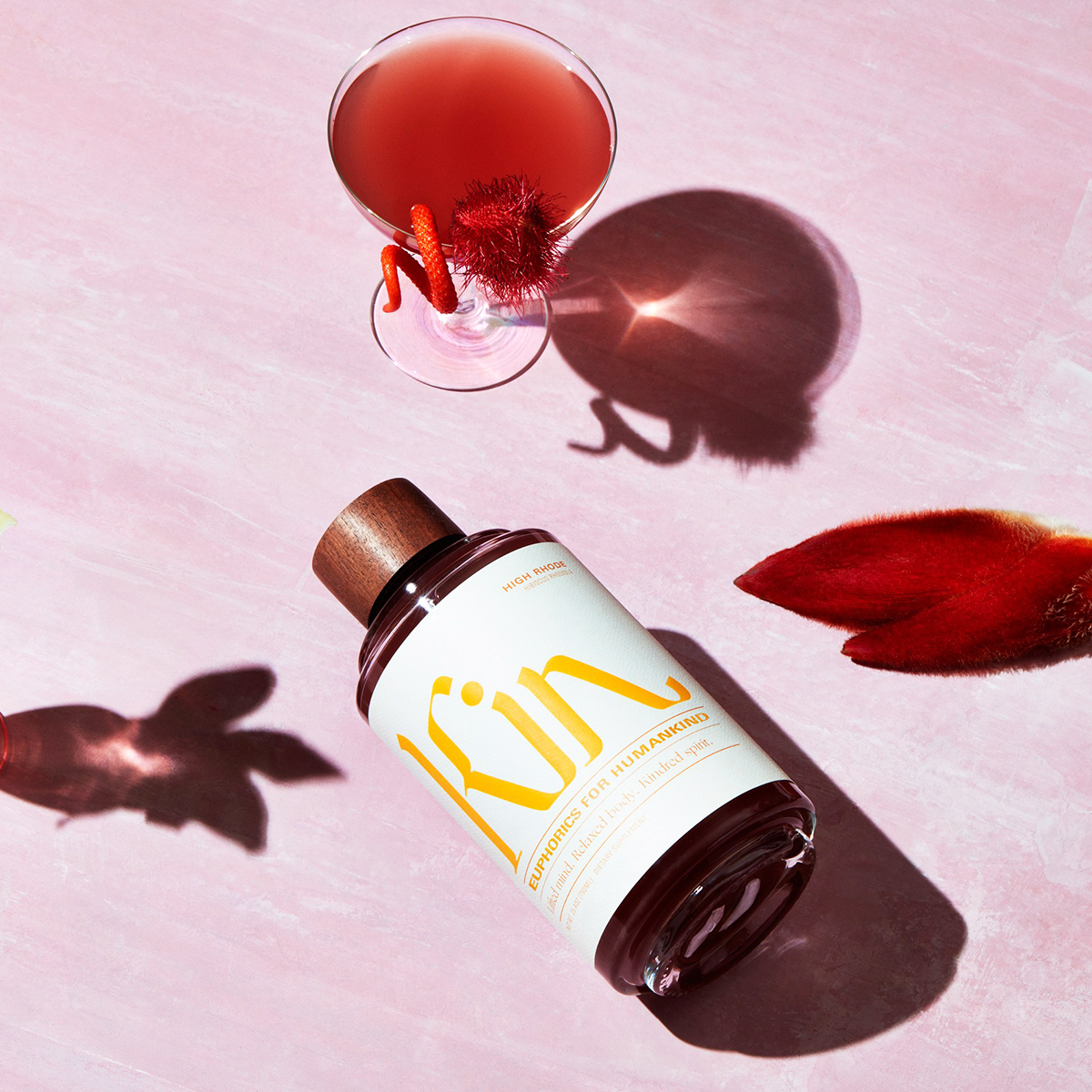This Euphoria-Inducing Drink Actually Made Monday Enjoyable for Me


"PLEASE READ," read the emphatic email from a co-worker. "Faux drunk is the new drunk."
It's not exactly uncommon for colleagues to flag me on new products, but this particular note was compelling enough for me to emerge from my proverbial writing cave and double-click it open. And as I parsed through the PR spiel about the brand in question—a self-described "euphoric" called Kin—my sense of intrigue only surged, even if my skepticism was in hot pursuit. (I'm immersed in an industry that unfortunately runs rampant with oversold promises and false marketing, so you'll forgive me for thinking that a drink claiming to induce feelings of bliss might be too good to be true.)
But my co-worker's own trial with Kin—"I'm shook," she said, "It really does give you a buzz"—was enough to keep me interested, as was the ingredient label. The brand's first official offering, called High Rhode ($39), contains a calorie-free blend of adaptogens, botanicals, and a class of ingredients entitled "nootropics," a buzzword I recognized from recent conversations with a few different leading wellness experts. Eager to learn more directly from the source, I quickly set a meeting with co-founder Jen Batchelor. On a sunny autumn afternoon the following week, she poured me my first glass of Kin.
At the time of our meeting, the brand was gearing up for its first round of orders, which sold out so swiftly I didn't even manage to nab a bottle in time. Since then, the buzz around it has only grown as Batchelor and her team have successfully marketed Kin as a novel (and sleekly branded) way to elevate a night out. In addition to its direct-to-consumer commerce strategy, the brand has begun to work with the beverage teams at sceney bars and venues in New York and Los Angeles.
It all begs the question: What is this stuff? To really understand, it's worth first diving into the science of nootropics.
What are nootropics?
Put simply, nootropics are any kind of substance that enhances cognitive function in a certain way, says Batchelor. The term was first coined in 1972 by Corneliu Giurgea, a Romanian psychologist and chemist who was particularly interested in synthesizing medications that could potentially make us smarter.
According to his original classification, a substance can be defined as a nootropic if it meets the following criteria:
- It enhances memory and learning capacity.
- It helps the brain better cope with stress.
- It protects the brain from physical and chemical injury.
- It improves the way the brain fires commands.
- It possesses few or no side effects.
When I first began to read about nootropics, I was immediately struck by their similarity to adaptogens, which bolster our brain chemistry in a different way, namely, by balancing our hormonal response to stress. But while the comparison is valid, says Batchelor, it's also important to note that adaptogens tend to be synergistic in nature (which is why some of us might feel the effects of ashwagandha more than others, for example), nootropics work in a more direct manner by targeting specific neurotransmitters like dopamine and serotonin.
Many startups (Dave Asprey's Bulletproof, for example) have opted to lean on some of the more performance-oriented effects of nootropics, like focus and memory recall. But Batchelor saw a different kind of white space: "Something kind of naughty" that bridged the gap between her wellness routine and playtime, instead of widening those margins. "I also started noticing a weird trend among my friends where they were drinking wine alone in the bathtub and posting about it—#detoxtoretox," she recalls. "Social media was making us less social while making drinking more glamorous? The irony was heartbreaking."
Her mission, she says, was clear: "[I wanted to] create something for stress relief that was fun and sophisticated enough to gather my friends around." It would take two years of exploration and meticulous research for Batchelor and her team to bring that vision to life.
How Kin Works
What makes Kin so interesting—and, as I'd find out, highly effective—is that it uses a blend of both nootropics and adaptogens, alleviating stress and facilitating a feeling of bliss in one go. For Batchelor, it was also of the utmost importance to formulate a product that didn't just honor Giurgea's original criteria but also relied heavily on botanical ingredients. The blend of nootropics, adaptogens, and functional herbs found in Kin was crafted to replenish our dopamine, serotonin, and GABA stores. "These are the parts of the brain responsible for helping us feel relaxed, open, curious, and connected," says Batchelor.
"We consider largely herbal applications as well as those designed in a lab," she adds. "Essentially, we choose the best quality ingredient for the job with an emphasis on symbiotic function as opposed to the Western switchboard approach where the application is more linear. Instead of aspirin to turn off pain receptors, for example, it's rose hip to calm the central nervous system, which can lead to a sense of relaxation. These are applied sciences that are expressed more as a subtle art than a magic bullet."
What it feels like
Ever the willing guinea pig, I have to say it was fascinating to monitor my own reaction to Kin under different dosages and social circumstances—starting with that October afternoon on my office patio with Batchelor herself. "It should feel like the equivalent of a glass of red wine and a hit of a joint," she said as she poured me a Kin cocktail—a statement that, though Kin has since pivoted away from any alcohol comparisons, certainly felt accurate as I giddily sat back down at my desk to finish up my day an hour later.
But for my next test, it only seemed fitting to try Kin in the setting it was intended for: a night out. This time, I recruited a friend to imbibe with me and upped the dosage to two servings since we had no plans to drink any alcohol the rest of the night (for the integrity of the experiment, of course). We were still commiserating over an exhausting day of work when we started sipping on a tasty combo of Kin and soda water. Thirty minutes later, we practically bounced into our Lyft to meet up with other friends, any sense of fatigue a distant memory.
The next morning sealed the deal when I woke up feeling spritely despite a very late bedtime. As I powered through my workday, I realized that I felt better than just not hungover. I was more productive than I had been all week, even after a very late bedtime.
This clear-headed morning put a finer point on the brilliance behind Batchelor's idea, not to mention its execution. Hangovers tend to bring out my most hermitic tendencies, but here I was, rallying at the office, asking a co-worker if she wanted to grab some coffee. I remembered every awesome moment spent with my friends the night before. Kin has recently rebranded to adopt the term "euphorics," but its initial name—"social tonic"—echoed in my mind as I realized how much it fostered shared experience.
To declare that Kin will better society at large seems rather hyperbolic. ("It's a tall order," admits Batchelor.) But it's also the ethos that has driven her brand forward, and the buzz (so to speak) around Kin suggests that we crave disruption to our current social patterns more than we think.
"We believe that by creating a new revelry experience," she says, "one that taps into our bliss network—neural and spiritual—allowing us more opportunities for pleasurable exchanges, creativity, kindness, and long-lasting memories, that we can change the way we relate to one another."
Next up: I Tried This Buzzy New Metabolism Powder for 20 Days Straight—Prepare for TMI
This article was originally published at an earlier date and has been updated.
Disclaimer
This article is provided for informational purposes only and is not intended to be used in the place of advice of your physician or other medical professionals. You should always consult with your doctor or healthcare provider first with any health-related questions.
-
 Hot Take: This Trending Dress Color Is Prettier Than Pink, Red, and White
Hot Take: This Trending Dress Color Is Prettier Than Pink, Red, and WhiteSorry, I said it.
By Nikki Chwatt
-
 This Tasteful Shoe Trend Makes Black Skinny Pants Look So Classy
This Tasteful Shoe Trend Makes Black Skinny Pants Look So ClassyPhoebe Dynevor knows what's up.
By Erin Fitzpatrick
-
 From Coach to Louis Vuitton, Meet the Chicest Looks From the 2025 WNBA Draft
From Coach to Louis Vuitton, Meet the Chicest Looks From the 2025 WNBA DraftLive from New York.
By Eliza Huber
